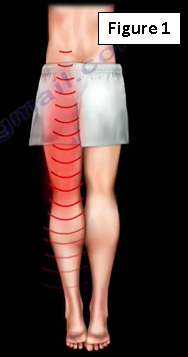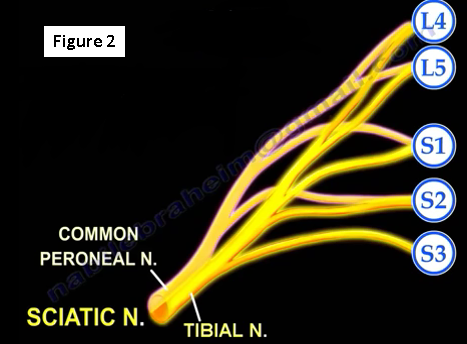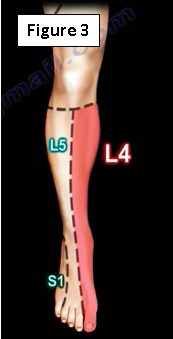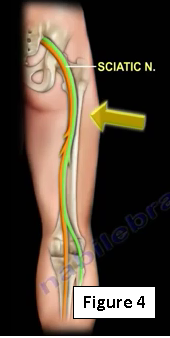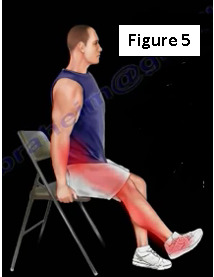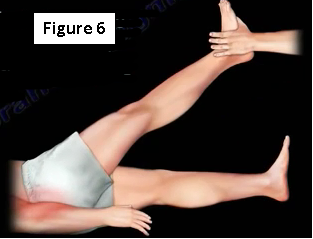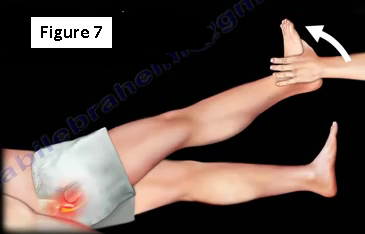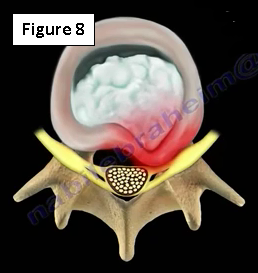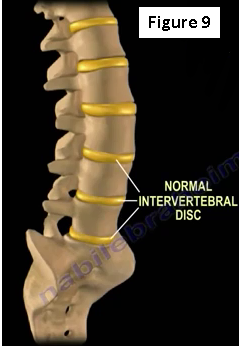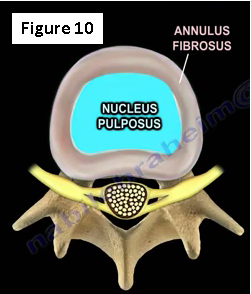Sciatica is a condition in which the sciatic nerve or any of its roots or branches is compressed, resulting in pain in the lower back and buttock. The pain is usually a sharp shooting pain in the leg or down to the foot. Typically, it affects one side of the body (Figure 1).
The sciatic nerve arises from the lumbosacral plexus. The sciatic nerve originates from L4, L5, S1, S2 and S3 (Figure 2). There are five nerve roots and each one has its own area of motor or sensory supply.
When a nerve root is compressed, it gives pain and symptoms in a specific area. The most common cause of sciatica is a disc herniation. For example a disc herniation between L5/S1, which will affect the S1 nerve root and the pain will shoot to the lateral side of the foot. If the L4 nerve root is involved, this will affect the medial side of the foot (Figure 3). If the L5 nerve root is involved, the top of the foot is affected.
These dermatomes are important in knowing which level is the herniated disc. For the diagnosis of sciatica, this is not very important for a non-medical person. Sciatica means a sharp shooting pain down the buttock, leg and foot. Sciatica may be self-diagnosed.
What is the course of the sciatic nerve?
The sciatic nerve starts in the lower back and runs through the buttock and lower limb. The sciatic nerve runs predominantly in the posterior aspect of the buttock and the lower extremity (Figure 4).
Symptoms and Signs
There will be sharp, shooting pain down the buttock, thigh, leg and down the foot. These symptoms of shooting pain are usually on one side of the body with numbness, tingling and burning. The area of symptoms and pain usually depend upon the nerve that is involved. Sitting may aggravate the nerve, causing more pain (Figure 5). Similar to the straight leg raise sign, sitting will place tension or a stretch on the nerve. Coughing, sneezing, or moving may also aggravate the sciatic nerve, causing pain. Sciatic pain will improve by standing or lying down. It feels like a nerve pain and the patient can usually diagnose sciatica.
Provocative Tests
Provocative tests are test that the doctor will perform to reproduce the pain. The physician should warn the patient that this will increase the pain. The straight leg raise sign will be used (Figure 6). With the patient either sitting or supine, raising of the leg will reproduce the pain and paresthesia at 30-70 degrees of hip flexion. This helps to identify if the patient is a good candidate for surgery. If the patient has a positive tension sign, they will improve with surgery. The Lasegue's sign will also be utilized. Straight leg raising pain is aggravated by forced ankle dorsiflexion (Figure 7).
What are the causes of sciatica?
Sciatica usually occurs due to a herniated disc of the lumbar spine (Figure 8).
What is a disc herniation?
The intervertebral disc is an elastic soft cushion that is between the vertebrae of the spine (Figure 9). It connects the vertebrae together, gives stability to the spine, and allows the spine to move. The intervertebral disc has two parts; the annulus fibrosus (tough fibrous outer layer) and the nucleus pulposus (soft gel-like inner layer) (Figure 10). If the soft gel-like inner material leaks out or herniates through a tear in the fibrous outer layer, it becomes a disc herniation. A tear of the disc may allow the gel-like material in the center of the disc to protrude and leak out, causing a herniation of the disc, which presses into the nerve root as it exits the spine. This irritates the close by nerve root, causing sciatica. Sciatica is one of the most common symptoms of lumbar disc herniation.
Treatment
Treatment will initially include anti-inflammatory medication, muscle relaxation and physical therapy. Usually the condition resolves itself in a few weeks. If the pain does not improve after six weeks of conservative treatment and the pain is severe and incapacitating, surgery is considered. The surgery is usually done to remove the offending herniated disc and relieve the pressure being placed on the nerve. The surgery is usually a discectomy or laminotomy.
The likelihood of a good outcome is increased from surgery if the patient has leg pain, a positive straight leg raise sign, neurological deficit, and the clinical findings will correspond and match the MRI findings.
Piriformis syndrome can also cause sciatica-like symptoms and this needs to be differentiated from sciatica that is caused by a disc related problem (Figure 11). Both may have the same symptoms, but have different causes. The diagnosis of piriformis syndrome should be done by exclusion of any possible spine problems, which could be compressing the spinal nerve root and causing true sciatica. If the patient complains of sciatica and the MRI does not show that there is a disc or spine problem, then the patient probably has piriformis syndrome.
Disclosure: The information presented in this article is a collection of public information related to sciatica.
For more information about sciatica, follow the links below:
https://www.youtube.com/watch?v=X48js6Ixbbw
https://www.youtube.com/watch?v=Jmsf_N1PeTE
https://www.youtube.com/watch?v=AWR1M90NG5s
https://www.youtube.com/watch?v=AahZDgd5EsM
https://www.youtube.com/watch?v=E53d0sEpcI8
https://www.youtube.com/watch?v=fJ6sFqV4pkQ
https://www.youtube.com/watch?v=dQH9AED6rsA
https://www.youtube.com/watch?v=8Myo7DrPWAM
For more information, visit my YouTube Channel:
https://www.youtube.com/user/nabilebraheim
